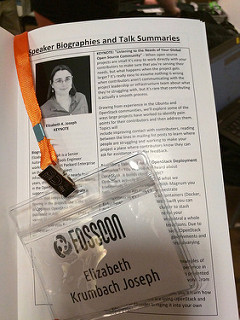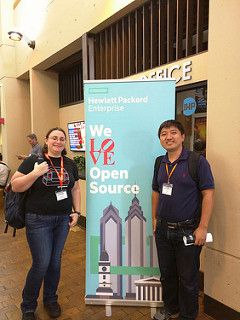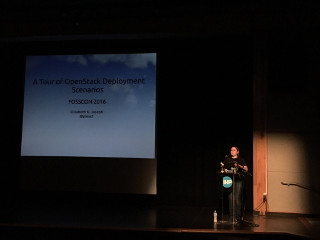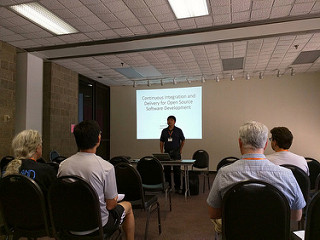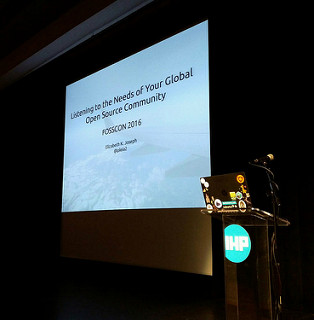Last week I was in Philadelphia, which was fun and I got to do some Ubuntu stuff but I was actually there to speak at FOSSCON. It’s not the largest open source conference, but it is in my adopted home city of Philadelphia and I have piles of friends, mentors and family there. I love attending FOSSCON because I get to catch up with so many people, making it a very hug-heavy conference. I sadly missed it last year, but I made sure to come out this year.
They also invited me to give a closing keynote. After some back and forth about topics, I ended up with a talk on “Listening to the Needs of Your Global Open Source Community” but more on that later.
I kicked off my morning by visiting my friends at the Ubuntu booth, and meeting up with my OpenStack and HPE colleague Ma Dong who had flown in from Beijing to join us. I made sure we got our picture taken by the beautiful Philadelphia-themed banner that the HPE open source office designed and sent for the event.
At 11AM I gave my regular track talk, “A Tour Of OpenStack Deployment Scenarios.” My goal here was to provide a gentle introduction, with examples, of the basics of OpenStack and how it may be used by organizations. My hope is that the live demos of launching instances from the Horizon web UI and OpenStack client were particularly valuable in making the connection between the concepts of building a cloud the actual tooling you might use. The talk was well-attended and I had some interesting chats later in the day. I learned that a number of the attendees are currently using proprietary cloud offerings and looking for options to in-house some of that.
The demos were very similar to the tutorial I gave at SANOG earlier this month, but the talk format was different. Notes from demos here and slides (219K).
For lunch I joined other sponsors at the sponsor lunch over at the wonderful White Dog Cafe just a couple blocks from the venue. Then it was a quick dash back to the venue for Ma Dong’s talk on “Continuous Integration And Delivery For Open Source Development.”
He outlined some of the common mechanisms for CI/CD in open source projects, and how the OpenStack project has solved them for a project that eclipses most others in size, scale and development pace. Obviously it’s a topic I’m incredibly familiar with, but I appreciated his perspective as a contributor who comes from an open source CI background and has now joined us doing QA in OpenStack.
After his talk it was also nice to sit down for a bit to chat about some of the latest changes in the OpenStack Infrastructure. We were able to catch up about the status of our Zuul tooling and general direction of some of our other projects and services. The day continued with some chats about Jenkins, Nodepool and how we’ve played around with infrastructure tooling to cover some interesting side cases. It was really fun to meet up with some new folks doing CI things to swap tips and stories.
Just before my keynote I attended the lightning talks for a few minutes, but had to depart early to get set up in the big room.
They keynote on “Listening to the Needs of Your Global Open Source Community” was a completely new talk for me. I wrote the abstract for it a few weeks ago for another conference CFP after the suggestion from my boss. The talk walked through eight tips for facilitating the collection of feedback from your community as one of the project leaders or infrastructure representatives.
- Provide a simple way for contributors to contact project owners
- Acknowledge every piece of feedback
- Stay calm
- Communicate potential changes and ask for feedback
- Check in with teams
- Document your processes
- Read between the lines
- Stick to your principles
With each of these, I gave some examples from my work mostly in the Ubuntu and OpenStack communities. Some of the examples were pretty funny, and likely very familiar with any systems folks who are interfacing with users. The Q&A at the end of the presentation was particularly interesting, I was very focused on open source projects since that’s where my expertise lies, but members of the audience felt that my suggestions were more broadly applicable. In those moments after my talk I was invited to speak on a podcast and encouraged to write a series of articles related to my talk. Now I’m aiming for writing some OpenSource.com content on over the next couple weeks.
Slides from the talk are here (7.3M pdf).
The conference wound down and following the keynote with a raffle and we then went our separate ways. For me, it was time for spending time with friends over a martini.
A handful of other photos from the conference here: https://www.flickr.com/photos/pleia2/albums/72157671843605132


